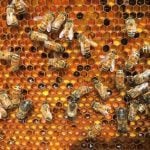A balanced diet is as important for crops as it is for people.
In crops, nitrogen is typically the nutrient promising the most yield benefit. But the other macronutrients – phosphorus, potassium and sulfur – also need to be in balance to get the best possible crop yields and cheapest input cost.
“You can’t just focus on N. You have to manage, N, P, K and S,” said Saskatchewan Agriculture soil specialist Ken Panchuk. “The way to do that is with a soil test.”
Canola offers a good illustration of why balancing nutrients is important. To reach target yields, producers often think about nitrogen first.
Read Also

Claims filed in Alberta hailstorm aftermath
The numbers are still coming in for the cost of the damage caused by a huge hail storm that hit various areas of Alberta Aug. 20.
However, a sulfur deficiency can limit the benefits of increasing the available N to reach target yields.
If a producer wants a canola yield of 30 to 40 bushels per acre, and puts down 100 pounds of N per acre, the yields could average only 15 bu. an acre in sulfur-deficient soils.
A rough rule of thumb is that for every 100 lb. of nitrogen that will be available to the canola crop, there should be 20 lb. of sulfur available, providing an N to S ratio of 5:1.
Canola has a higher requirement for S than most crops grown in Western Canada, said Agriculture Canada soil scientist Cindy Grant.
Sulfur is important for protein production, so crops that are high in protein need more S than low protein crops.
“As you push your yields, as your push your nitrogen, then you correspondingly have to increase the amount of sulfur that’s available.”
The message about balancing nitrogen and sulfur in canola is one that producers have heard before, but Panchuk believes it bears repeating.
Producers using elemental sulfur should broadcast it on the surface of the field, preferably in the fall. That allows time for the granules to disperse and break down, Panchuk said. These fine particles can then be oxidized by microbes that may make only some of the sulfur available to crops the following year.
Grant said it is difficult to predict how much of the elemental S will be available, since the conversion is affected by temperature, moisture and other factors affecting microbial activity.
Panchuk encouraged producers to use the sulfate form of sulfur, that is plant-available, when fertilizing canola to be sure there is enough for the target yield.
All crops need some sulfur, said Grant. Although wheat needs less than canola, wheat growers should still keep the nutrient in mind.
Another nutrient needed for crop production in most prairie areas is phosphorus. The exceptions tend to be in fields where manure is applied.
When applying commercial phosphorus fertilizers Panchuk recommends placing it either with or very near the seed at planting time.
Phosphorus gets tied up in the soil quickly and does not move far from where it was applied.
Placing it near the seed helps ensure that it’s readily available to the crop as it begins establishing roots. Soils can still be cold at seeding time, which slows the root growth needed to tap nutrients in the soil.
Phosphorus helps promote healthy root systems under cool soil conditions and is necessary for nitrogen fixation by legume and pulse crops.
“I think most producers are managing their phosphorus pretty well,” Grant said.
She advises against pushing phosphorus levels in sensitive crops, such as canola.
Increasing P rates above those that can safely be seed-placed will not likely increase yield, said Grant. For a narrow opener, the safe rate for canola is usually about 20 kilograms of phosphate per hectare as monoammonium phosphate.
The nutrients most likely to be deficient in prairie crops are nitrogen, phosphorus and sulfur.
However, potassium is also a nutrient to watch, especially in sandy soils, said Grant.
Alfalfa requires a lot of potassium. A potassium deficiency in alfalfa can reduce the plant’s vigour, winter hardiness and ability to compete with grasses in the field.
All crops need potassium to grow, but most of that nutrient will be returned to the soil if the straw is left in the field as residue.
Understanding soils can help when managing the four main nutrients. In light textured soils, nutrients are more likely to leach out because the soils usually can’t hold them as well as heavier textured soils.
Drought stress and flooding can also change the nutrient balance.
















